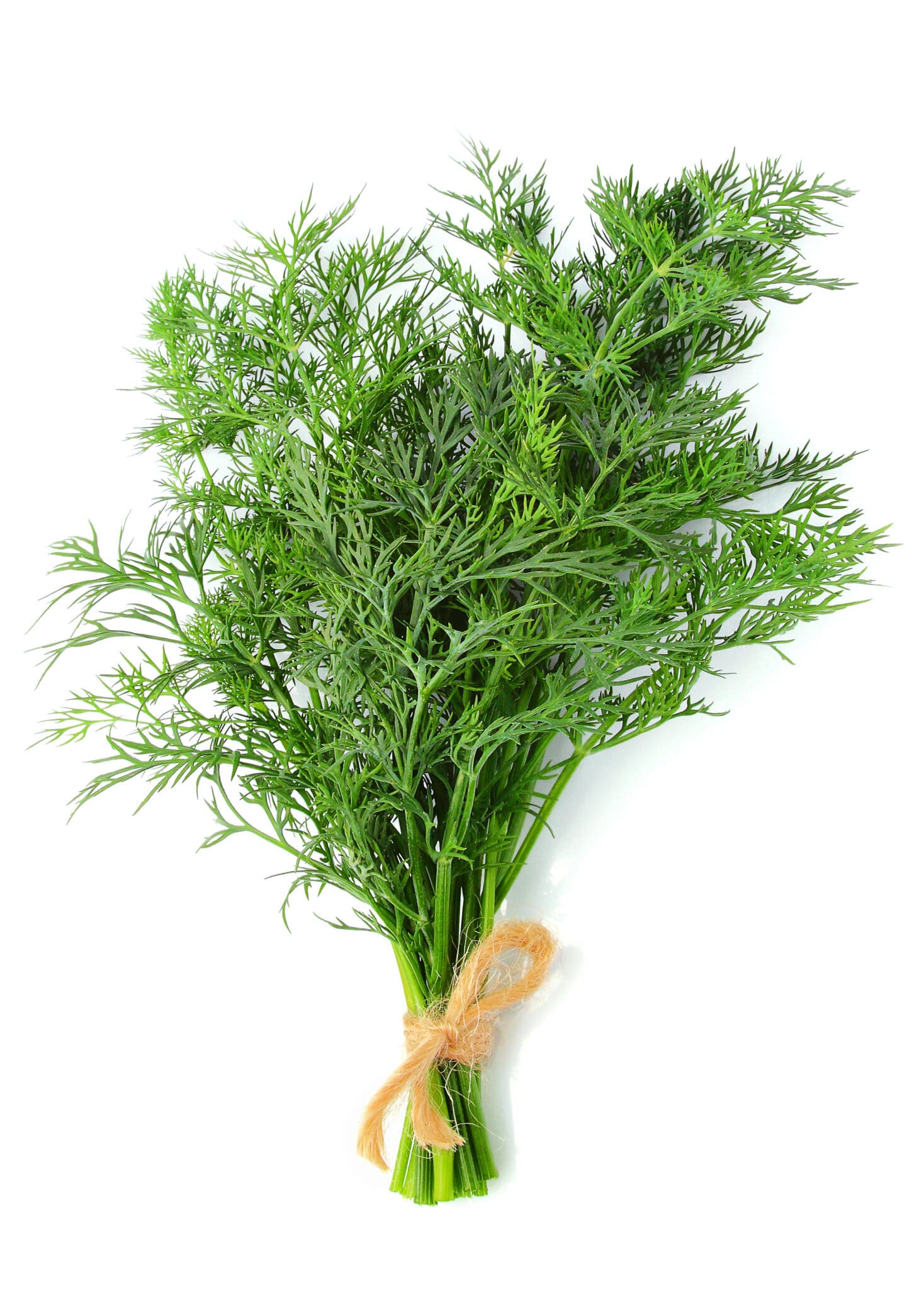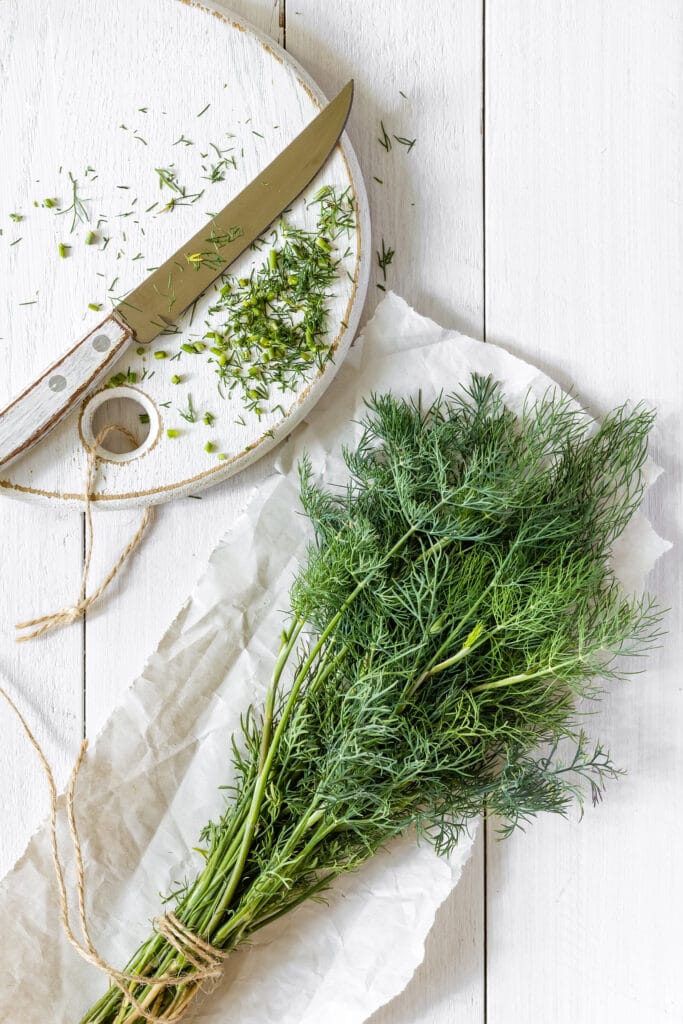Dill Plants: How To Grow, Harvest & Use Them
Dill is a must-have herb for any garden! Grow it and use it to make pickles, throw it in your favorite recipes, or add it to your fresh-cut flower arrangements. From planting your seeds to harvesting your dill plants, here’s everything you need to know about growing dill.

I appreciate versatility in life. That’s why I like to grow plants that can be used in several different ways such as rosemary and basil.
Multi-purpose plants that can be used in your recipes as well as non-culinary uses such as DIY body products, ornamentals, or as garden helpers are what I’m all about!
And today, I have another herb guide to share with you.
When you think of growing dill, you probably think of pickling cucumbers. Sure, dill absolutely helps to create some delicious pickles, but dill plants can be used in so many other ways too!
Let’s explore this popular herb and learn how to care for it as well as some of the different ways to use your fresh dill.
Note: If you love herbs, be sure to read up on growing mint plants and thyme plants, too!
Dill Plants: A Brief History
Part of the Apiaceae family, dill is a tender annual in the same family as carrots. Its feathery appearance looks similar to fennel, but it’s actually more closely related to anise, caraway, parsley, and cilantro.
The plant is believed to have originated in the Mediterranean area and Asia Minor. It’s a staple in the dishes and cuisines of the area. And, thanks to its versatility and delicious flavor, it’s now used in many different ways all around the globe!
Benefits of Dill
In addition to their amazing flavor, dill plants boast many beneficial vitamins and minerals to promote great overall health. This herb is rich in vitamin A, vitamin C, and magnesium and is packed with flavonoids that may help protect against stroke, heart disease, and some cancers.
Here are a few non-culinary benefits that dill plants provide.
- Eases constipation
- Relieves indigestion
- Alleviates anxiety and depression
- Reduces nervousness
Fun Facts About Dill Plants
Don’t you just love learning random fun things about plants? Here are a few fun facts about dill plants.
- Dill plants have a tendency to self-sow. If you want seeds for next year, let them grow. Otherwise, remove flower heads to encourage leaf production.
- You can use fresh dill leaves whole or cut up.
- Fresh dill leaves lose some of their fragrance and flavor when heated, so add them to the end of a recipe to get the most flavor.
- You can use dill flowers the same way you would use the leaves!
- Dill plants are fascinating because they are both herb and spices. The fresh leaves (called dill weed) are used as an herb in recipes such as salads, meats, vegetables, and sauces. On the other hand, the dried seeds are the spice and can be used in recipes that cook longer such as soups, stews, bread, egg dishes, pickles, and more..

Growing Dill Plants: Everything You Need To Know For Success
Dill plants aren’t fussy which makes them a cinch to grow. It’s ideal for beginners to add to their herb garden. Here’s what this plant needs to thrive.
Growing Needs Of Dill Plants
- Scientific name: Anethum graveolens
- When to plant: Toss seeds into the garden after the last frost and lightly cover them with soil.
- Light: Dill plants want full sun, but other than that they aren’t picky.
- Soil: Rich soil, poor soil – it doesn’t matter!
- Fertilizing: Not usually needed.
- Watering: Dill can grow well in damp or dry soil.
- Hardiness Zones: 3-11
Ideal Locations For Growing Dill
I love a good fuss-free plant, which plants dill firmly on my “approved” list. As long as it has lots of sunlight, it’s usually pretty happy. Try growing dill:
- In garden beds (raised or in the ground)
- In your containers
- As an indoor herb
Keeping Dill Plants Healthy
Here are a few things to keep in mind when growing dill plants so they stay healthy and happy.
Harmful Pests
Dill can fall prey to:
- Parsley caterpillars
- Tomato hornworms
If you notice them attacking your dill plants, pick them off by hand. Then, spray with Bacillus thuringiensis kurstaki (known as BTK insecticide)to keep them away.
Fungal Diseases
Dill plants don’t have much of a problem with fungal diseases. I told you growing dill was easy!

Harvesting Dill
To harvest your dill, all you need to do is trim off the number of leaves you want to use in your recipe.
If you want to harvest seeds from your dill plant, here’s how:
- Allow your plant to grow until it blooms (don’t trim it).
- Once it blooms, it will stop growing leaves and put its energy into developing seed pods.
- Cut the whole flower head off your dill plant and put it into a paper bag after the seed pods turn brown.
- Shake the bag gently to make the seeds fall off the flower head.
- Remove the flower head from the bag and keep the seeds.
If you want to harvest a larger amount but want it to continue growing and producing leaves (say for a large recipe), you can safely cut off up to ⅔ of the plant at one time.
Storing And Preserving Dill
While I recommend using harvested dill right away, you can store it in different ways to prolong its use.
Store fresh dill leaves by layering them in damp paper towels and putting them in a bag in the fridge for up to 2 days.
If you want to harvest dill seeds, cut off the flower heads before the seeds fully dry and fall to the ground. Then, hang the flower heads upside down in a paper bag for a few weeks until the seeds ripen and fall off the flower head into the bag.
Freezing your dill leaves is a great way to preserve your fresh dill so you can use it all year long. Simply put your fresh dill leaves into a freezer-safe bag and pull them out as you need them.

Ways To Use Dill Plants
Dill plants are popular for use in a large variety of recipes. I love to use them to make my homemade pickles in a jar!
Here are a few other ideas that come to mind:
In Cooking
Using dill in culinary recipes is one of the most common uses for this flavorful herb. Although it’s native to the Mediterranean region, it’s a staple in many different cuisines. Add dill to:
- Pickle recipes
- Bread recipes
- Meat recipes
- Fish dishes
- Salads
- Soups
- Flavored butter or spreads
- Sauces and dips
- Flavored vinegar
- Spice blends
- Garnish
- And more!

Aromatherapy
Dill is calming and uplifting when used aromatically. Add it to your diffuser as well as sprays, potpourri, or candles to give you a positive boost when you’re feeling overwhelmed.
DIY Bath And Beauty Products
Dill can be added to many DIY body care products such as:
- Face wash
- Face cream
- Lip gloss
- Salt scrub
- Face masks
I hope that this post gave you some helpful tips on growing and using dill plants in ways you never thought to before! Whether you want to let its beauty shine in flower arrangements or highlight its fresh, tangy flavor in recipes, there are tons of reasons for growing dill in your garden.
More Gardening Resources
- Growing Cucumbers: When And How To Harvest Cucumbers
- 11 Easy Vegetables to Grow for Beginners That will Produce all Summer Long.
- Cilantro Plant: How To Grow, Harvest & Use Them
- How To Plan A Vegetable Garden In 7 Easy Steps
- Seed Saving Basics: How to Save Seeds From Your Garden
- How To Make Potpourri Using Dry Flowers And Herbs
- How Long Do Dried Flowers Last?
- How To Pickle Jalapenos To Last You All Winter





